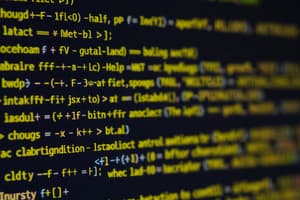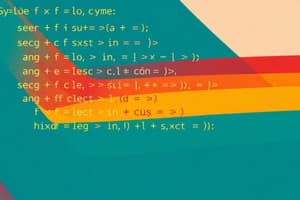Podcast
Questions and Answers
The course "Introduction to Programming" is also known as ______ 101.
The course "Introduction to Programming" is also known as ______ 101.
CS
The lecture discussed the ______ loop, increment/decrement operators, and constants.
The lecture discussed the ______ loop, increment/decrement operators, and constants.
for
The recap section focused on the "dangling else" problem in ______ if statements.
The recap section focused on the "dangling else" problem in ______ if statements.
nested
The code snippet included the ______ library.
The code snippet included the ______ library.
The missing portion of the code snippet likely involves the use of the ______ operator.
The missing portion of the code snippet likely involves the use of the ______ operator.
Flashcards
For Loop
For Loop
A control structure for repeating a block of code multiple times.
Increment Operator
Increment Operator
An operator (++) that increases a variable's value by one.
Decrement Operator
Decrement Operator
An operator (--) that decreases a variable's value by one.
Dangling Else Problem
Dangling Else Problem
Signup and view all the flashcards
Nested If Statement
Nested If Statement
Signup and view all the flashcards
Study Notes
Lecture 5: Introduction to Programming (CS 101)
- Course: Introduction to Programming (CS 101)
- Semester: Spring 2024
- Instructor: Preethi Jyothi
- Lecture materials based on material developed by Prof. Abhiram Ranade
Recap-I (Nested if): Dangling else problem
- Code snippet with nested
ifstatements provided - Output from the provided code is ambiguous about output/logic due to possible errors in the formatting/nesting of code
- Correct understanding of program output depends on the precise way the statements are grouped in the code
Recap-II (while statement)
- Program's output (in words) for a given input
n = 44 - Value of p printed when
n = 44in awhileloop program is32 #include <simplecpp>statement is standard for simple C++ programs- Program snippet demonstrates C++ code which takes input
nand calculatespiteratively
Recap-III (while and break)
- Demo in class and code (guess.cpp) shared on Moodle
Constants
-
Lecture topic is constants
-
Course: CS 101, 2025
-
Constant definition: constant value doesn't change throughout the program
-
const int i = 1;defines integer variableiand initializes with the value1 -
iis a constant in this code -
1is a literal in this code -
Constants must be properly initialized and declared
-
Using constants over literals improves code readability and maintainability
for statement
- Lecture topic is
forstatements in CS101, 2025
Motivation: for statement
- Program example: prints a cube table for numbers from 1 to 100
repeat(100)loop structure can be functionally replaced by aforloop.
for syntax and semantics
- Syntax of a
forloop in C++ with initialization, condition, and update statements - Semantics/logic of
forloop: initialization runs before first iteration, condition evaluates repeatedly within iteration, body gets executed when condition is true, update runs after each iteration, loop stops when condition is false. - Examples of C++ for loop
while and for
- Comparison between
whileandforloops - Illustrates how the
forloop is used as a concise structure rather than thewhileloop which can be used instead - Explains how variables work within loops, and their scopes
for examples
repeat(n)loop can be replaced with aforloop that is better suited in those scenariosforloops are better with certain iterative patterns
Increment, decrement operators
- Explanation of increment (++), and decrement (--) operators in C++
- Pre increment
++ifirst incrementsithen uses the incremented value. - Post increment
i++uses the existing value of i, and then incrementsi. - Difference between pre and post increment/decrement operators is important.
- Example code demonstrating how different increment operator varieties are used and what outputs they produce.
Increment, decrement operators (continued)
- Using increment and decrement in a nested loop for example
- Detailed explanation of the differences between pre and post increment and decrement operators using multiple examples to showcase their practical use in C++ coding practices and the specific outputs they will produce.
nested for example
- Example: nested for loops
- Illustrates how nested for loops are created
- Shows how nested loops are functionally and methodologically different
Another for example
- Example of a
forloop that handles non-numerical input or a mix of numerical and text input - Processing character-by-character within a loop
break across different loop structures
-
breakstatement functionality in different types of loops (while,do-while,for) and nested loops -
Breaks the loop structure when executed
continue across different loop structures
-
continuestatement functionality in different types of loops (while,do-while,for) and nested loops -
Skips rest of the loop structure after being executed
continue in a nested loop
- Example: program with nested
forloops and acontinuestatement - Illustrates how "continue" impacts the behaviour of nested loops
Next class: Internal Representations of data types
- Topic preview for the next class is internal representations of data types.
Studying That Suits You
Use AI to generate personalized quizzes and flashcards to suit your learning preferences.




